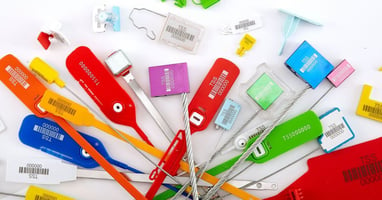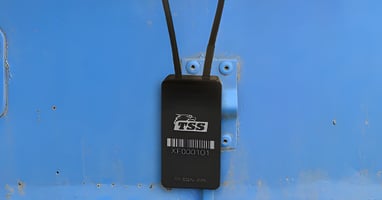Tamper-evident seals safeguard products during transportation to guarantee their authenticity upon...
How RFID Seals Utilize Technology for Shipment Protection

Find out how RFID seals utilize technology for shipment protection, enhancing security, real-time tracking, and efficiency across industries worldwide.
With billions of dollars’ worth of goods moving across supply chains daily, businesses face mounting pressure to protect their assets and ensure flawless deliveries for clients. Because of this, outdated security methods are no longer an option.
RFID seals are tech devices that can create smarter, more secure shipment tracking. Understanding how RFID seals utilize technology for shipment protection reveals how transformative these seals are. Uncover the full potential of this innovative technology and how you can transform your shipment security for the better.
The Evolution of Shipment Security From Locks to RFID Seals
Shipment security has come a long way in recent years. While physical locks served as a foundational security measure for centuries, the evolving demands of modern logistics necessitated a more sophisticated solution. Manual methods of securing and tracking shipments often led to inefficiencies and errors, making it difficult to ensure the complete safeguarding of goods.
The rise of digital solutions in the late twentieth century initiated shifts in how enterprises approach supply chain security. Traditional lock-and-key mechanisms gave way to tamper-evident tape and plastic seals, which provided an additional layer of protection. But as the pace and volume of global trade increased, these measures began to show their limitations.
RFID seals emerged as a game-changer, combining tamper-evident features with enhanced tracking and data management capabilities. By merging physical security with digital data, RFID technology addresses the dual demands of efficiency and security in today’s complex supply chains. This leap forward allows logistics professionals to track their shipments with unprecedented accuracy and ease.

Basics of RFID Technology
To understand how RFID seals work, you first need to grasp the basics of RFID technology. RFID stands for radio frequency identification. It’s a wireless communication system where small electronic tags, called RFID tags, exchange data over radio waves with a reading device.
An RFID system typically has three components:
- The RFID tag: This can be active (battery-powered) or passive (powered when scanned). It stores data such as a serial number or a unique shipment identifier.
- The reader/scanner: This device transmits and receives signals to and from the RFID tag.
- A backend system: This is where the collected data is processed, stored, and analyzed.
Unlike barcodes, RFID doesn’t require a direct line of sight for scanning. A reader can detect RFID tags even when they’re embedded within objects, making them faster and more efficient for tracking and monitoring shipments.
How RFID Seals Work
RFID seals combine the physical security of traditional tamper-evident seals with the digital functionality of RFID technology. These seals are often placed on containers, pallets, or individual items within a shipment. Here’s a step-by-step explanation of how they work:
- Activation and tagging: Logistics teams activate the RFID seal and assign it to a specific shipment. Information such as the container’s origin, destination, and content details are stored on the seal’s RFID tag.
- Seal placement: The seal is securely attached to the shipment. Any attempt to remove or tamper with the seal will physically break it, providing visual evidence of interference.
- Tracking and monitoring: While in transit, RFID readers installed at checkpoints, warehouses, or ports can scan the seal to verify its integrity and location.
- Tamper detection and alerts: Sensors in advanced RFID seals trigger alerts if someone breaks or tampers with the seal. The system flags anomalies in real-time, enabling immediate intervention.
- Data integration: The RFID seal transmits insights to backend systems, allowing logistics teams to view the shipment’s status, location, and historical data.
This seamless combination of physical and digital security makes RFID seals a powerful tool for safeguarding shipments.
Common Misconceptions About RFID Seals
Despite their widespread adoption, several misconceptions surround RFID seals and their capabilities. Understanding what RFID can and cannot do is essential for deploying the technology effectively.
RFID Seals and GPS Seals
One of the most common misunderstandings is equating RFID seals with GPS-enabled seals. While GPS technology provides continuous location data independently, RFID seals require proximity to a scanner to transmit their data. This means RFID seals don’t provide live location updates.
Active and Passive RFID Tags
Another point of confusion is the distinction between active and passive RFID tags. Passive RFID seals, commonly used in logistics, rely on the energy from a scanner to communicate. They do not have their own power source. On the other hand, active tags have an internal battery and can transmit signals over long distances, but they typically cost more upfront.
Security Capabilities
While RFID seals enhance security by providing tamper evidence and easy data management, they are not foolproof. Combining RFID with other tools, such as GPS or blockchain, results in an optimal solution for end-to-end shipment transparency.

The Benefits of Using Security Seals With Technology
Adopting RFID security seals offers numerous advantages for companies looking to optimize their transportation processes and protect their cargo. Here are the key benefits of this innovative technology:
- Streamlined operations: By automating the scanning and logging of shipment details, RFID seals reduce the time spent on manual processes.
- Tamper evidence: RFID seals provide visible tamper evidence while digitally verifying shipment integrity at different touchpoints.
- Accurate data management: The data collected by RFID scanners is accurate, eliminating human error and ensuring compliance with regulatory standards.
- Enhanced supply chain transparency: RFID-powered systems allow supply chain managers to monitor shipments with precise information about where and when a package was scanned.
- Scalability: Ground-up compatibility with modern software makes RFID seals suitable for enterprises of all sizes.
By integrating RFID into supply chain management systems, enterprises can significantly cut costs, mitigate risks, and elevate customer trust.
Partner With Logimate for Premium RFID Seals
When it comes to securing your shipments and boosting efficiency, partnering with the right companies is essential. Logimate offers a wide range of premium RFID-enabled seals designed to meet the needs of supply chain managers, logistics professionals, and security experts. Our seals are ideal for high-volume distribution centers and ports, providing unparalleled support for both security and operational requirements.
Utilizing RFID seal technology for shipment protection is strategically imperative in our modern global economy. Leveraging innovative solutions for your cargo drives efficiency while safeguarding your assets. With Logimate, you can build a safer, smarter logistics ecosystem tailored to your business needs.




